Analog and Digital Bipolar Resistive Switching in Co–Al-Layered Double Hydroxide Memristor
Abstract
:1. Introduction
2. Materials and Methods
3. Results and Discussion
4. Conclusions
Supplementary Materials
Author Contributions
Funding
Conflicts of Interest
References
- Sokolov, A.S.; Son, S.K.; Lim, D.; Han, H.H.; Jeon, Y.R.; Lee, J.H.; Choi, C. Comparative study of Al2O3, HfO2, and HfAlOx for improved self-compliance bipolar resistive switching. J. Am. Ceram. Soc. 2017, 100, 5638–5648. [Google Scholar] [CrossRef]
- Raab, N.; Schmidt, D.O.; Du, H.; Kruth, M.; Simon, U.; Dittmann, R. Au Nanoparticles as Template for Defect Formation in Memristive SrTiO3 Thin Films. Nanomaterials 2018, 8, 869. [Google Scholar] [CrossRef] [PubMed] [Green Version]
- Zhou, G.; Ren, Z.; Wang, L.; Wu, J.; Sun, B.; Zhou, A.; Zhang, G.; Zheng, S.; Duan, S.; Song, Q. Resistive switching memory integrated with amorphous carbon-based nanogenerators for self-powered device. Nano Energy 2019, 63, 103793. [Google Scholar] [CrossRef]
- Sun, B.; Zhou, G.; Guo, T.; Zhou, Y.N.; Wu, Y.A. Biomemristors as the next generation bioelectronics. Nano Energy 2020, 75, 104938. [Google Scholar] [CrossRef]
- Yagati, A.K.; Kim, S.-U.; Lee, T.; Min, J.; Choi, J.-W. Recombinant azurin-CdSe/ZnShybrid structures for nanoscale resistive random access memory device. Biosens. Bioelectron. 2017, 90, 23–30. [Google Scholar] [CrossRef]
- Simanjuntak, F.M.; Prasad, O.K.; Panda, D.; Lin, C.A.; Tsai, T.L.; Wei, K.H.; Tseng, T.Y. Impacts of Co doping on ZnO transparent switching memory device characteristics. Appl. Phys. Lett. 2016, 108, 183506. [Google Scholar] [CrossRef]
- Sun, B.; Chen, Y.; Xiao, M.; Zhou, G.; Ranjan, S.; Hou, W.; Zhu, X.; Zhao, Y.; Redfern, S.A.T.; Zhou, Y.N. A Unified Capacitive-Coupled Memristive Model for the Nonpinched Current- Voltage Hysteresis Loop. Nano Lett. 2019, 19, 6461–6465. [Google Scholar] [CrossRef]
- Dias, C.; Guerra, L.M.; Bordalo, B.D.; Lv, H.; Ferraria, A.M.; Botelho do Rego, A.M.; Cardoso, S.; Freitas, P.P.; Ventura, J. Voltage-polarity dependent multi-mode resistive switching on sputtered MgO nanostructures. Phys. Chem. Chem. Phys. 2017, 19, 10898–10904. [Google Scholar] [CrossRef]
- Wei, L.J.; Yuan, Y.; Wang, J.; Tu, H.Q.; Gao, Y.; You, B.; Du, J. Bipolar resistive switching with negative differential resistance effect in a Cu/BaTiO3/Ag device. Phys. Chem. Chem. Phys. 2017, 19, 11864. [Google Scholar] [CrossRef]
- Lv, W.; Wang, H.; Jia, L.; Tang, X.; Lin, C.; Yuwen, L.; Wang, L.; Huang, W.; Chen, R. Tunable Nonvolatile Memory Behaviors of PCBM-MoS2 2D Nanocomposites through Surface Deposition Ratio Control. ACS Appl. Mater. Interfaces 2018, 10, 6552–6559. [Google Scholar] [CrossRef]
- Banerjee, W. Challenges and Applications of Emerging Nonvolatile Memory Devices. Electronics 2020, 9, 1029. [Google Scholar] [CrossRef]
- Banerjee, W.; Liu, Q.; Lv, H.; Long, S.; Liu, M. Electronic imitation of behavioral and psychological synaptic activities by the TiOx/Al2O3-based memristor devices. Nanoscale 2017, 9, 14442–14450. [Google Scholar] [CrossRef] [PubMed]
- Pei, Y.; Mai, B.; Zhang, X.; Hu, R.; Li, Y.; Chen, Z.; Fan, B.; Liang, J.; Wang, G. Performance improvement of amorphous indiumgallium-zinc oxide ReRAM with SiO2 inserting layer. Curr. Appl. Phys. 2015, 15, 441–445. [Google Scholar] [CrossRef]
- Rosner, B.; Ran, K.; Butz, B.; Schmidt, U.; Spiecker, E.; Fink, R.H. A microspectroscopic insight into the resistivity switching of individual Ag-TCNQ nanocrystals. Phys. Chem. Chem. Phys. 2015, 17, 18278–18281. [Google Scholar] [CrossRef] [Green Version]
- Chiappone, A.; Gillono, M.; Castellino, M.; Bejtka, K.; Rajan, K.; Roppolo, I.; Perrone, D.; Bocchini, S.; Ricciardi, C.; Pirri, C.F.; et al. In situ generation of silver nanoparticles in PVDF for the development of resistive switching devices. Appl. Surf. Sci. 2018, 455, 418–424. [Google Scholar] [CrossRef]
- Sun, L.; Zhang, Y.; Han, G. Self-selective van der Waals heterostructures for large scale memory array. Nat. Commun. 2019, 10, 3161. [Google Scholar] [CrossRef] [Green Version]
- Tapio, K.; Leppiniemi, J.; Shen, B.; Hytönen, V.P.; Fritzsche, W.; Toppari, J. Toward single electron nanoelectronics using self-assembled DNA structure. Nano Lett. 2016, 16, 6780–6786. [Google Scholar] [CrossRef]
- Kim, J.; Inamdar, A.I.; Jo, Y.; Woo, H.; Cho, S.; Pawar, S.M.; Kim, H.; Im, H. Effect of Electronegativity on Bipolar Resistive Switching in a WO3-Based Asymmetric Capacitor Structure. ACS Appl. Mater. Interfaces 2016, 8, 9499–9505. [Google Scholar] [CrossRef]
- Zhou, G.; Wu, B.; Liu, X.; Li, P.; Zhang, S.; Sun, B.; Zhou, A. Two-bit memory and quantized storage phenomenon in conventional MOS structures with double-stacked Pt-NCs in an HfAlO matrix. Phys. Chem. Chem. Phys. 2016, 18, 6509–6514. [Google Scholar] [CrossRef]
- Li, Y.; Chu, J.; Duan, W.; Cai, G.; Fan, X.; Wang, X.; Wang, G.; Pei, Y. Analog and Digital Bipolar Resistive Switching in SolutionCombustion-Processed NiO Memristor. ACS Appl. Mater. Interfaces 2018, 10, 24598–24606. [Google Scholar] [CrossRef]
- Pershin, Y.V.; Di Ventra, M. Practical Approach to Programmable Analog Circuits with Memristors. IEEE Trans. Circ. Syst. 2010, 57, 1857–1864. [Google Scholar] [CrossRef] [Green Version]
- Chang, T.; Jo, S.-H.; Lu, W. Short-Term Memory to Long-Term Memory Transition in a Nanoscale Memristor. ACS Nano 2011, 5, 7669–7676. [Google Scholar] [CrossRef] [PubMed]
- Chen, X.; Zhang, X.; Koten, M.A.; Chen, H.; Xiao, Z.; Zhang, L.; Shield, J.E.; Dowben, P.A.; Hong, X. Interfacial charge engineering in ferroelectric-controlled Mott transistors. Adv. Mater. 2017, 29, 1701385. [Google Scholar] [CrossRef] [PubMed]
- Raeis-Hosseini, N.; Lee, J.-S. Resistive Switching Memory Based on Bioinspired Natural Solid Polymer Electrolytes. ACS Nano 2015, 9, 419–426. [Google Scholar] [CrossRef]
- Jang, S.K.; Kim, S.; Salman, M.S.; Jang, J.-R.; Um, Y.M.; Tan, L.; Park, J.-H.; Choe, W.-S.; Lee, S. Harnessing Recombinant Protein as Reversible Metal Chelator for a High-Performance Resistive Switching Device. Chem. Mater. 2018, 30, 781–788. [Google Scholar] [CrossRef]
- Zhu, S.; Sun, B.; Ranjan, S.; Zhu, X.; Zhou, G.; Zhao, H.; Mao, S.; Wang, H.; Zhao, Y.; Fu, G. Mechanism analysis of a flexible organic memristive memory with capacitance effect and negative differential resistance state. APL Mater. 2019, 7, 081117. [Google Scholar] [CrossRef]
- Zhao, X.; Ma, J.; Xiao, X.; Liu, Q.; Shao, L.; Chen, D.; Liu, S.; Niu, J.; Zhang, X.; Wang, Y.; et al. Breaking the Current-Retention Dilemma in Cation-Based Resistive Switching Devices Utilizing Graphene with Controlled Defects. Adv. Mater. 2018, 30, 1705193. [Google Scholar] [CrossRef]
- Zhu, S.; Zhang, X.; Sun, B.; Mao, S.; Zheng, P.; Zhao, Y.; Xia, Y. Origin of a continuously enlarge memristor effect in Nb inserted into MgB2 multilayer constructed heterojunctions. Vacuum 2018, 151, 261–265. [Google Scholar] [CrossRef]
- Chen, K.-H.; Chang, K.-C.; Chang, T.-C.; Tsai, T.-M.; Liang, S.-P.; Young, T.-F.; Syu, Y.-E.; Sze, S.M. Illumination effect on bipolar switching properties of Gd:SiO2 RRAM devices using transparent indium tin oxide electrode. Nanoscale Res. Lett. 2016, 11, 224. [Google Scholar] [CrossRef] [Green Version]
- Ling, H.; Tan, K.; Fang, Q.; Xu, X.; Chen, H.; Li, W.; Liu, Y.; Wang, L.; Yi, M.; Huang, R.; et al. Light-tunable nonvolatile memory characteristics in photochromic RRAM. Adv. Electron. Mater. 2017, 3, 1600416. [Google Scholar] [CrossRef]
- Liu, K.-C.; Tzeng, W.-H.; Chang, K.-M.; Chan, Y.-C.; Kuo, C.-C. Effect of ultraviolet light exposure on a HfOx RRAM device. Thin Solid Films 2010, 518, 7460–7463. [Google Scholar] [CrossRef]
- Aga, F.G.; Woo, J.; Song, J.; Park, J.; Lim, S.; Sung, C.; Hwang, H. Controllable quantized conductance for multilevel data storage applications using conductive bridge random access memory. Nanotechnology 2017, 28, 115707. [Google Scholar] [CrossRef] [PubMed]
- Banerjee, W.; Hwang, H. Understanding of Selector-Less 1S1R Type Cu-Based CBRAM Devices by Controlling Sub-Quantum Filament. Adv. Electron. Mater. 2020, 6, 2000488. [Google Scholar] [CrossRef]
- Aga, F.G.; Woo, J.; Lee, S.; Song, J.; Park, J.; Park, J.; Lim, S.; Sung, C.; Hwang, H. Retention modeling for ultra-thin density of Cu-based conductive bridge random access memory (CBRAM). AIP Adv. 2016, 6, 025203. [Google Scholar] [CrossRef] [Green Version]
- Banerjee, W.; Liu, Q.; Hwang, H. Engineering of defects in resistive random access memory devices. J. Appl. Phys. 2020, 127, 051101. [Google Scholar] [CrossRef]
- Banerjee, W.; Hwang, H. Quantized conduction device with 6-Bit storage based on electrically controllable break junctions. Adv. Electron. Mater. 2019, 5, 1900744. [Google Scholar] [CrossRef]
- Ferrari, A.C.; Bonaccorso, F.; Fal’ko, V. Science and technology roadmap for graphene related two-dimensional crystals, and hybrid systems. Nanoscale 2015, 7, 4598–4810. [Google Scholar] [CrossRef] [Green Version]
- Cadore, A.R.; Mania, E.; Alencar, A.B.; Rezende, N.P.; de Oliveira, S.; Watanabe, K.; Taniguchi, T.; Chacham, H.; Campos, L.C.; Lacerda, R.G. Enhancing the response of NH3 graphene-sensors by using devices with different graphene-substrate distances. Sens. Actuators B Chem. 2018, 266, 438–446. [Google Scholar] [CrossRef] [Green Version]
- Toro, M.J.U.; Marestoni, L.D.; Sotomayor, M.D.P.T. A new biomimetic sensor based on molecularly imprinted polymersfor highly sensitive and selective determination of hexazinoneherbicide. Sens. Actuators B Chem. 2015, 208, 299–306. [Google Scholar] [CrossRef]
- Liu, Z.; Teng, L.; Ma, L.; Liu, Y.; Zhang, X.; Xue, J.; Ikram, M.; Ullah, M.; Li, L.; Shi, K. Porous 3D flower-like CoAl-LDH nanocomposite with excellent performance for NO2 detection at room temperature. RSC Adv. 2016, 9, 21911–21921. [Google Scholar] [CrossRef] [Green Version]
- Sun, H.; Chu, Z.; Hong, D.; Zhang, G.; Xie, Y.; Li, L.; Shi, K.J. Alloy. Compound 2016, 658, 561–568. [Google Scholar] [CrossRef]
- Calisto, J.S.; Pacheco, I.S.; Freitas, L.L.; Santana, L.K.; Fagundes, W.S.; Amaral, F.A.; Canobre, S.C. Adsorption kinetic and thermodynamic studies of the 2,4-dichlorophenox- yacetate (2,4-D) by the Co-Al-Cl. layered double hydroxide. Heliyon 2019, 5, e02553. [Google Scholar] [CrossRef] [PubMed] [Green Version]
- Wei, P.R.; Cheng, S.H.; Lee, C.H. Synthesis of chitosan-coated near-infrared layered double hydroxide nanoparticles for in vivo optical imaging. J. Matr. Chem. 2012, 22, 5503–5513. [Google Scholar] [CrossRef]
- Seo, J.W.; Park, J.-W.; Lim, K.S.; Kang, S.J.; Hong, Y.H.; Yang, J.H.; Fang, L.; Sung, G.Y.; Kim, H.-K. Transparent Flexible Resistive Random Access Memory Fabricated at Room Temperature. Appl. Phys. Lett. 2009, 95, 133508. [Google Scholar]
- Biju, K.P.; Liu, X.; Siddik, M.; Kim, S.; Shin, J.; Ki, I.; Ignatiev, A.; Hwang, H. Resistive switching characteristics and mechanism of thermally grown WOx thin films. J. Appl. Phys. 2011, 110, 064505. [Google Scholar] [CrossRef]
- Zhuge, F.; Li, J.; Chen, H.; Wang, J.; Zhu, L.Q.; Bian, B.R.; Fu, B.; Wang, Q.; Li, L.; Pan, R.B.; et al. Single-crystalline metal filament-based resistive switching in a nitrogen-doped carbon film containing conical nanopores. Appl. Phys. Lett. 2015, 106, 083104. [Google Scholar] [CrossRef]
- Pan, R.; Li, J.; Zhuge, F.; Zhu, L.; Liang, L.; Zhang, H.; Gao, J.; Cao, H.; Fu, B.; Li, K. Synaptic devices based on purely electronic memristors. Appl. Phys. Lett. 2016, 108, 013504. [Google Scholar] [CrossRef]
- Zhang, X.; Ikram, M.; Liu, Z.; Teng, L.; Xue, J.; Wang, D.; Li, L.; Shi, K. Expanded graphite/NiAl layered double hydroxide nanowires for ultra-sensitive, ultra-low detection limits and selective NOx gas detection at room temperature. RSC Adv. 2019, 9, 8768–8777. [Google Scholar] [CrossRef] [Green Version]
- Privman, M.; Rupp, E.B.; Zumam, P. Hexazinone: Polarographic reduction andadsorption on lignin. J. Agric. Food Chem. 1994, 42, 2946–2952. [Google Scholar] [CrossRef]
- Wang, H.; Yan, X.; Zhao, M.; Zhao, J.; Zhou, Z.; Wang, J.; Hao, W. Memristive devices based on 2D-BiOI nanosheets and their applications to neuromorphic computing. Appl. Phys. Lett. 2020, 116, 093501. [Google Scholar] [CrossRef]
- Tu, M.; Lu, H.; Luo, S.; Peng, H.; Li, S.; Ke, Y.; Yuan, S.; Huang, W.; Jie, W.; Hao, J. Reversible Transformation between Bipolar Memory Switching and Bidirectional Threshold Switching in 2D Layered K-Birnessite Nanosheets. ACS Appl. Mater. Interfaces 2020, 12, 24133–24140. [Google Scholar] [CrossRef] [PubMed]
- Xia, F.; Xu, Y.; Li, B.; Hui, W.; Zhang, S.; Zhu, L.; Xia, Y.; Chen, Y.; Huang, W. Improved Performance of CH3NH3PbI3−xClx Resistive Switching Memory by Assembling 2D/3D Perovskite Heterostructures. ACS Appl. Mater. Interfaces 2020, 12, 15439–15445. [Google Scholar] [CrossRef] [PubMed]
- Ranjan, A.; Raghavan, N.; O’Shea, S.J.; Mei, S.; Bosman, M.; Shubhakar, K.; Pey, K.L. Conductive Atomic Force Microscope Study of Bipolar and Threshold Resistive Switching in 2D Hexagonal Boron Nitride Films. Sci. Rep. 2018, 8, 2854. [Google Scholar] [CrossRef] [PubMed]


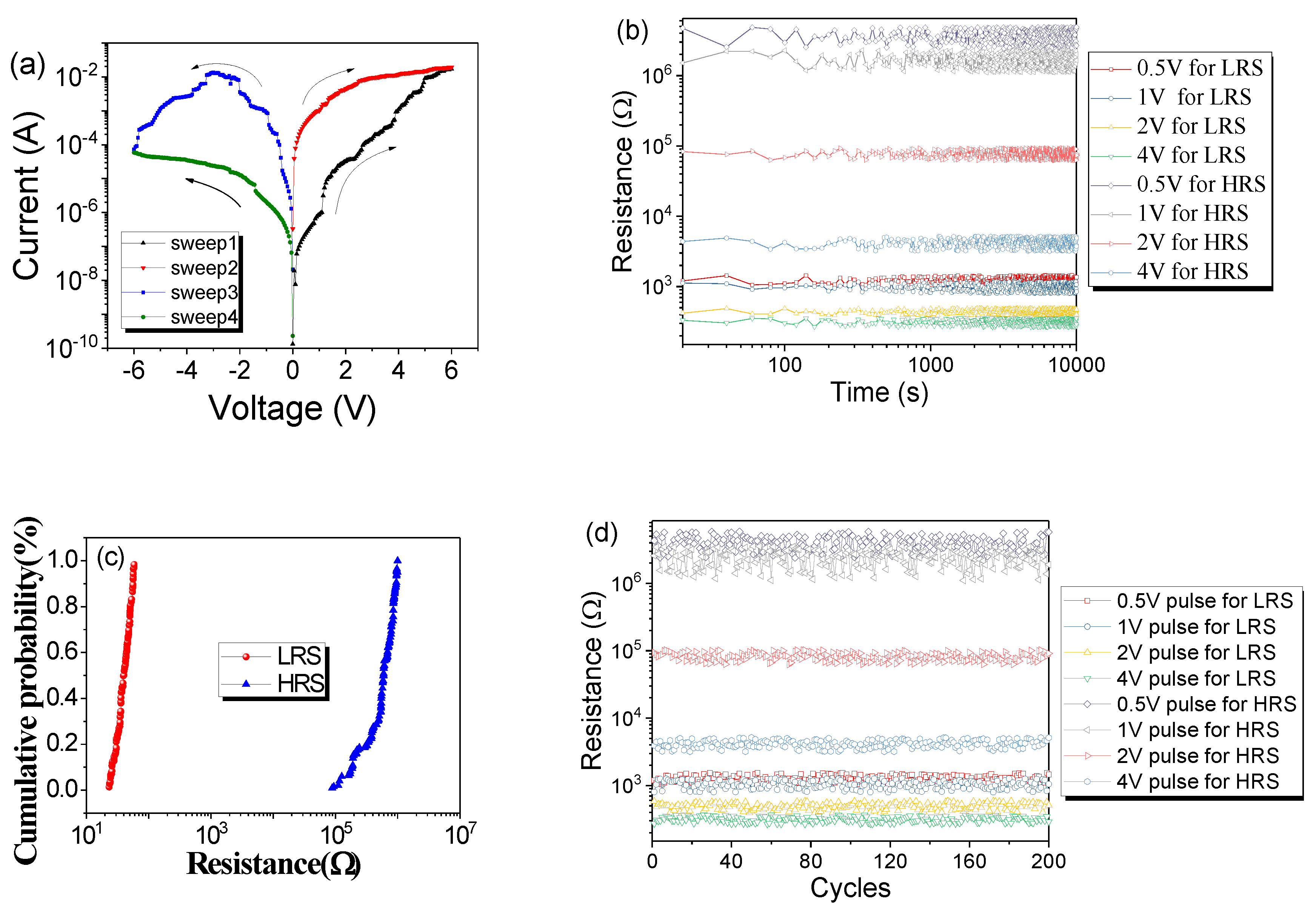
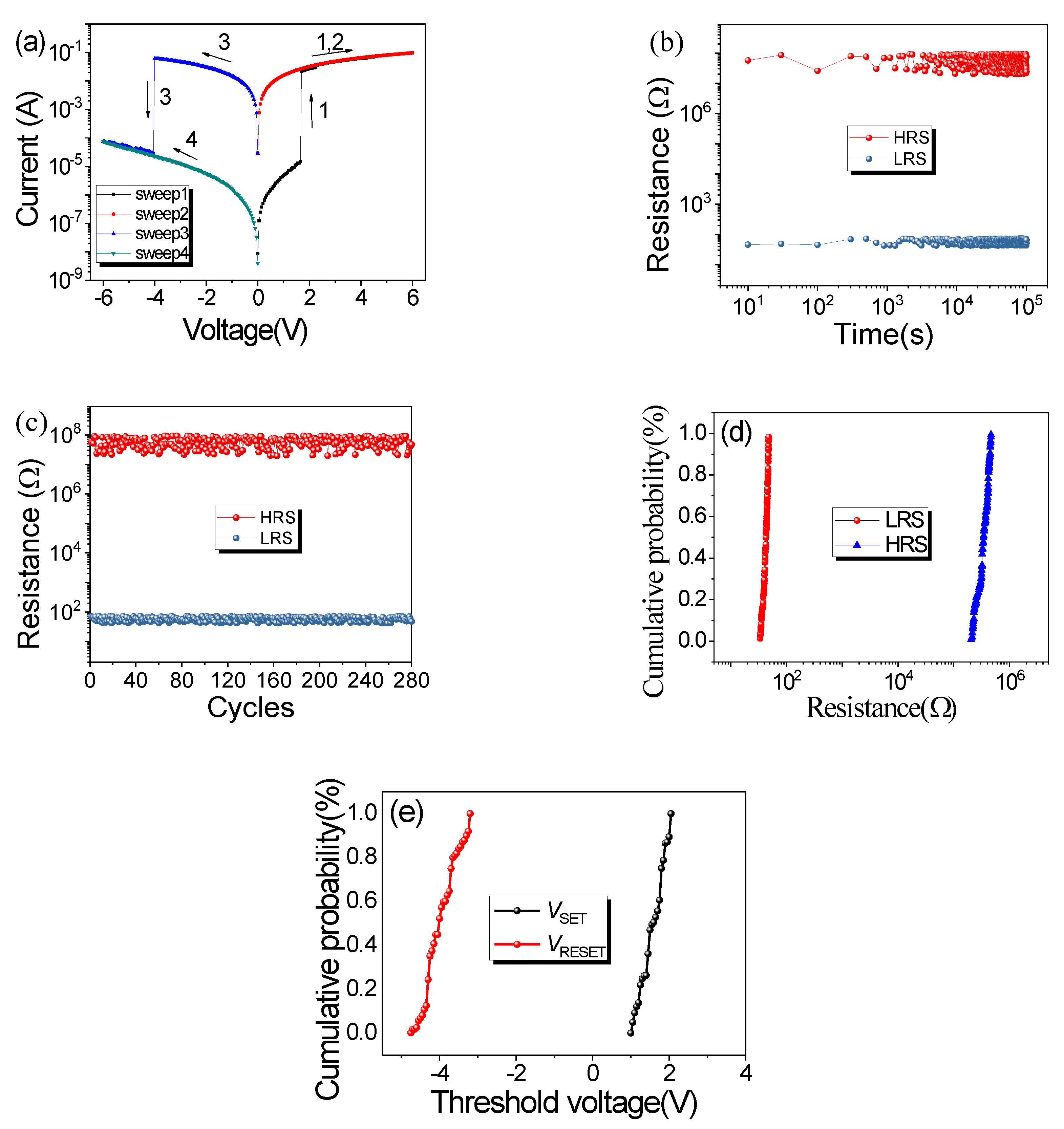
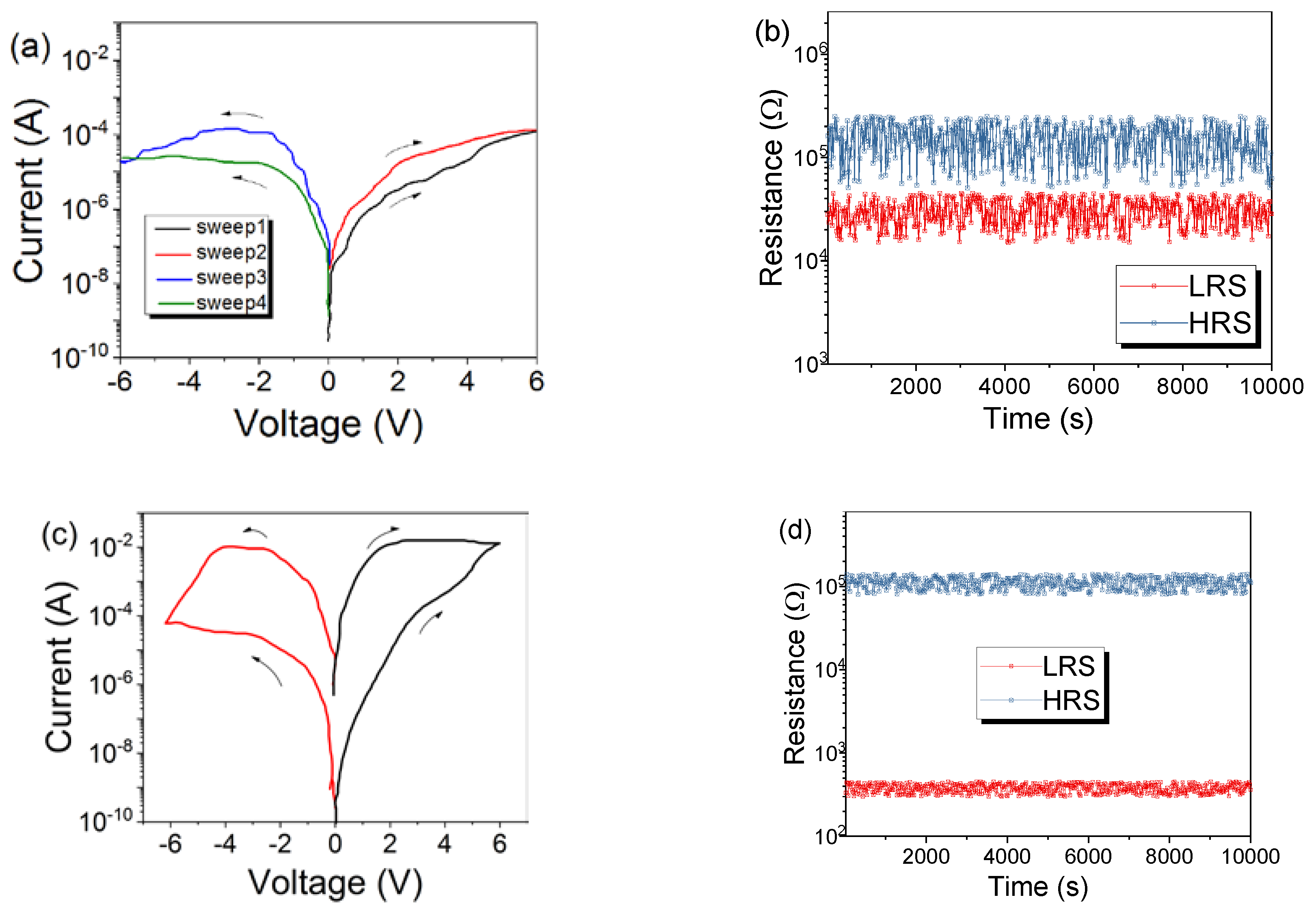
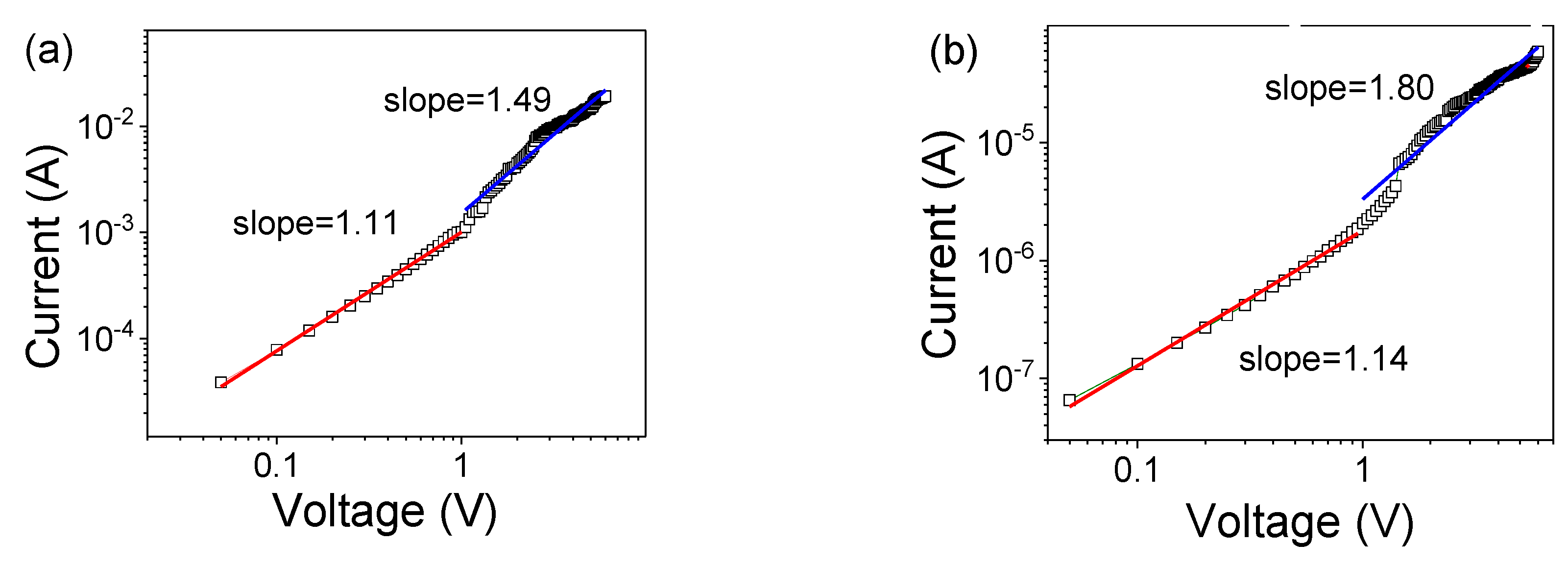
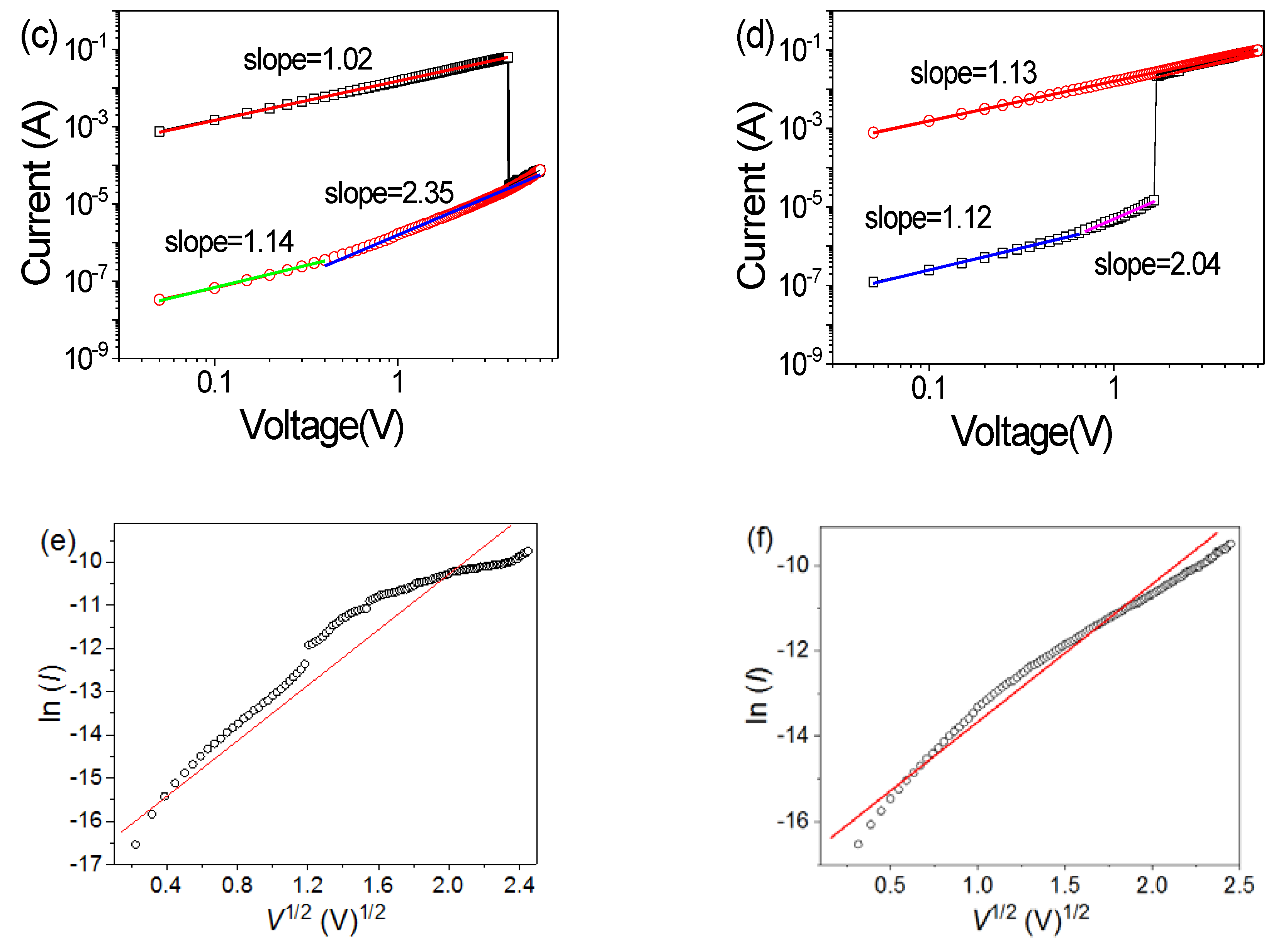
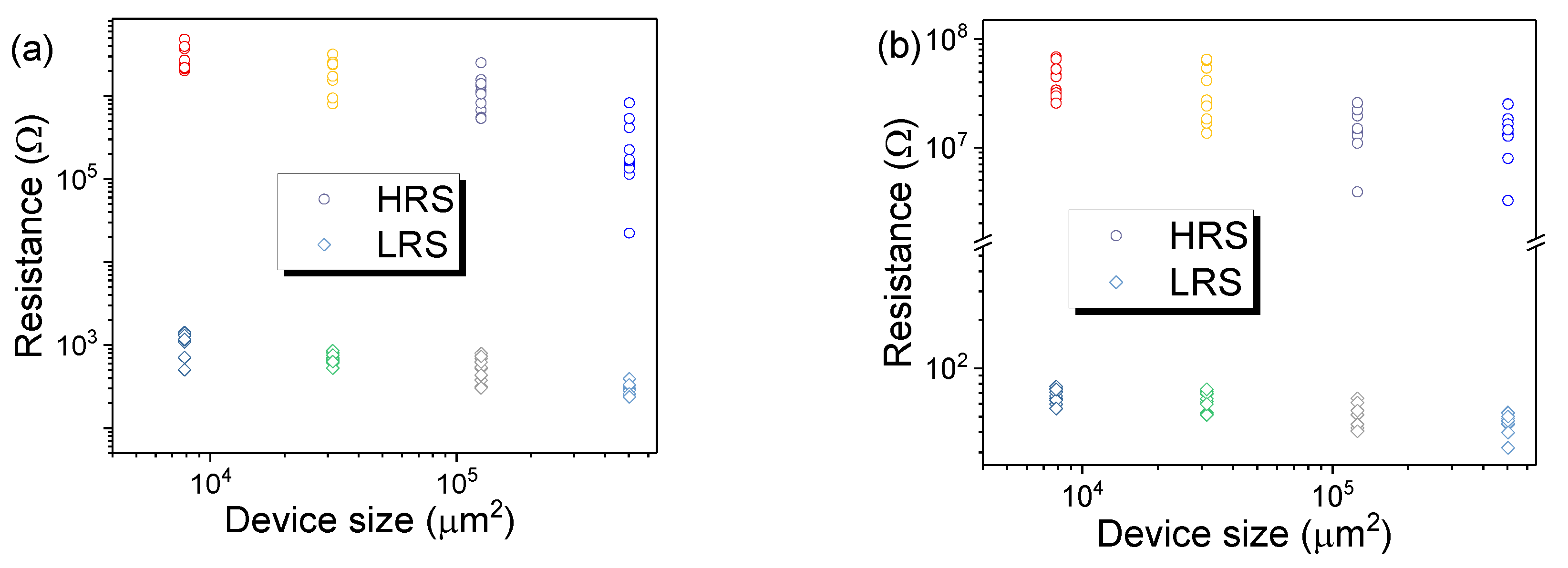
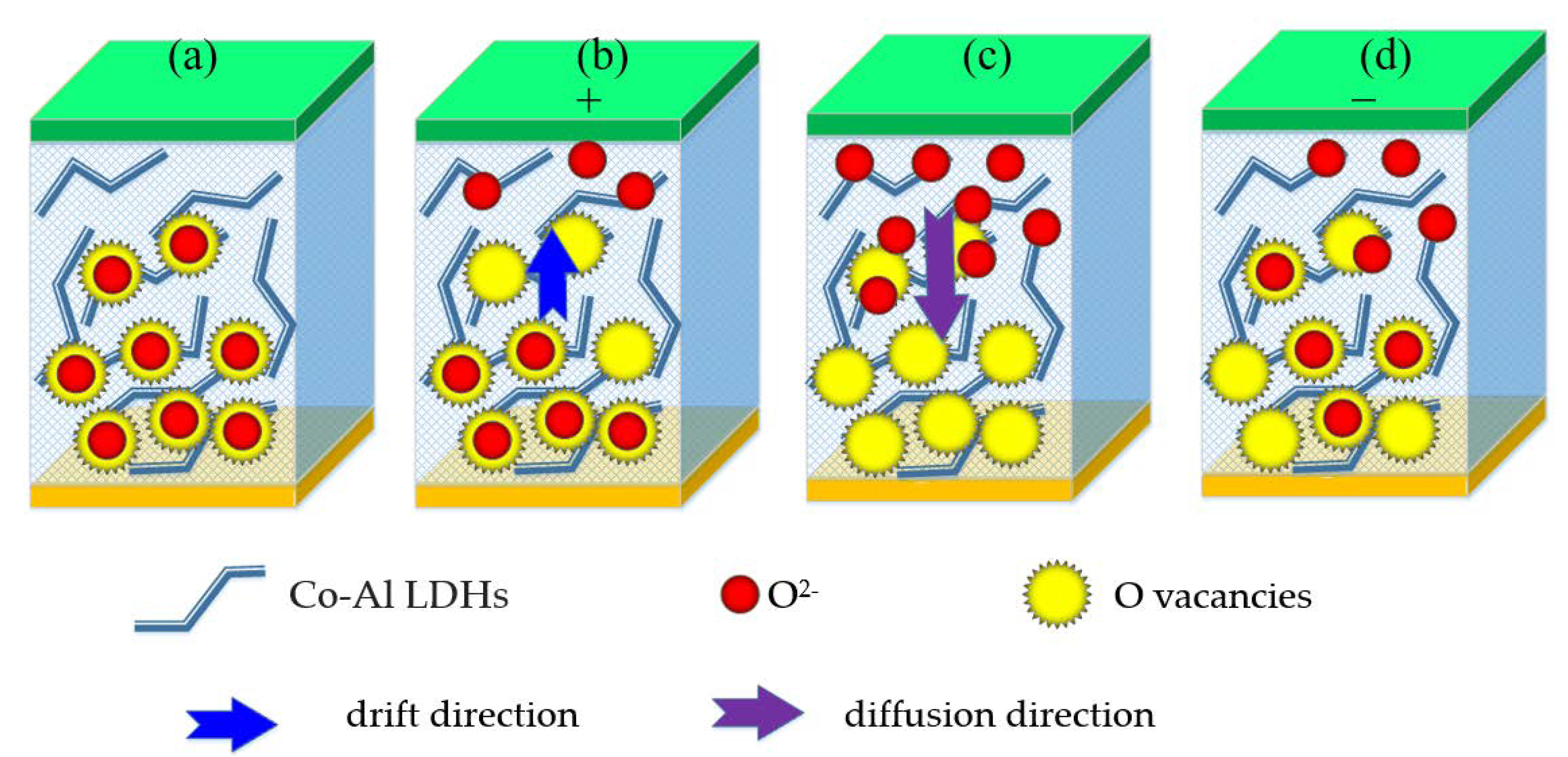

| Materials | Resistive Switching | Data Retention Characteristics | Endurance Characteristics (Cycles) | ON/OFF Resistance Ratio | Ref. |
|---|---|---|---|---|---|
| BiOI | Rewritable | 1.4 × 104 s | 100 | ~10 | [50] |
| PCBM–MoS2 nanocomposites | Rewritable/WORM | 1.0 × 104 s | 95 | ~3 × 100 (rewritable) | [10] |
| Layered K-Birnessite nanosheets | Nonvolatile memory switching/volatile threshold switching | 3.0 × 104 s | 800 | ~2 × 105 (memory switching) | [51] |
| 2D/3D heterostructure-based CH3NH3PbI3-xClx | Rewritable | 1.2 × 104 s | 300 | 103 | [52] |
| Hexagonal boron nitride | Bipolar and threshold resistive switching | 10–100 s | 200 | 102 | [53] |
| Co–Al LDH-adsorbed hexazinone | Rewritable | 105 s | 280 | 2.5 × 104 | This work |
Publisher’s Note: MDPI stays neutral with regard to jurisdictional claims in published maps and institutional affiliations. |
© 2020 by the authors. Licensee MDPI, Basel, Switzerland. This article is an open access article distributed under the terms and conditions of the Creative Commons Attribution (CC BY) license (http://creativecommons.org/licenses/by/4.0/).
Share and Cite
Sun, Y.; Li, L.; Shi, K. Analog and Digital Bipolar Resistive Switching in Co–Al-Layered Double Hydroxide Memristor. Nanomaterials 2020, 10, 2095. https://doi.org/10.3390/nano10112095
Sun Y, Li L, Shi K. Analog and Digital Bipolar Resistive Switching in Co–Al-Layered Double Hydroxide Memristor. Nanomaterials. 2020; 10(11):2095. https://doi.org/10.3390/nano10112095
Chicago/Turabian StyleSun, Yanmei, Li Li, and Keying Shi. 2020. "Analog and Digital Bipolar Resistive Switching in Co–Al-Layered Double Hydroxide Memristor" Nanomaterials 10, no. 11: 2095. https://doi.org/10.3390/nano10112095





